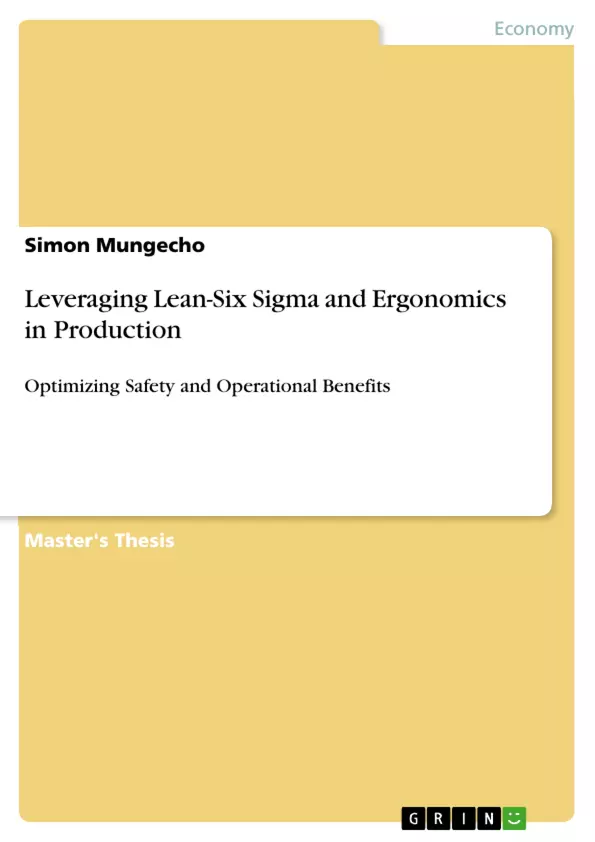This paper argues that implementing Lean-Six Sigma and ergonomics concurrently presents great opportunities for manufacturing companies. It focuses on how these companies could profit from addressing ergonomics- related injuries by leveraging Lean-Six Sigma with their ergonomics / safety programs. The paper also looks at how such a strategy could transform an organization, lower workers compensation claims’ costs, increase productivity, safety, efficiency, and improve the bottom-line. It is fundamental and critical for manufacturing companies with limited resources today, to harness the mutual benefits of investing on health and safety issues using methodology such as Lean-Six Sigma. The research concluded that manufacturing businesses that leveraged Lean-Six Sigma and ergonomics made significant improvements. There is no doubt from the study that work-related injuries are very expensive and can negatively affect an organization’s competitive advantage. They can also affect the quality of work and the workers. The paper concludes by outlining some successive models and recommendations.
Inhaltsverzeichnis (Table of Contents)
- ABSTRACT
- 1. INTRODUCTION
- 1.1 Motivation: Costs of work-related injuries
- 1.2 Benefits of Lean-Six Sigma
- 2. OCCUPATIONAL INJURIES
- 2.1 Estimated costs and Statistics
- 2.2 Risk factors work-related musculoskeletal disorders
- 2.3 Work-related musculoskeletal injuries
- 3. OPTIMIZATION TECHNIQUES.
- 3.1 DMAIC Process
- 3.1.1 Process Mapping and Flowcharts
- 3.1.2 Root Cause Analysis: Ishikawa diagram and the Five “Whys”
- 3.1.3 Multi-phase process: Define; Measure; Analyze; Improve; Control
- 3.2 Lean Process
- 3.2.1 Kaizen
- 3.2.2 Plan-Do-Check-Act Cycle
- 3.2.3 5S Methodology
- 3.3 Assessment Frameworks
- 3.4 Comparing Lean and Six Sigma Models
- 3.5 Participatory Ergonomics
- 3.6 The Nexus between Lean-Six Sigma and Ergonomics / Participatory
- 3.7 Contrast between Lean-Six Sigma thinking and Ergonomics / Participatory
- 3.1 DMAIC Process
- 4. IMPLEMENTATION AND DEPLOYMENT
- 4.1 Lean principles
- 4.2 Six-Sigma techniques
- 4.3 Participatory ergonomics and human factors
- 5. RESULTS AND CASE STUDIES.
- 5.1 Short-term and Long-term benefits
- 5.1.1 Examples in Manufacturing
- 5.1.2 Research data systematic review
- 5.1 Short-term and Long-term benefits
- 6. EFFECTIVENESS AND IMPACT.
- 6.1 Implementation Challenges and Limitations of Lean-Six Sigma
- 6.2 Effectiveness of leveraging Lean-Six Sigma
- 6.3 Effectiveness of leveraging Participatory Ergonomics
- 6.4 Impact of Lean-Six Sigma on musculoskeletal disorders / injuries
- 7. CONCLUSION AND RECOMMENDATIONS...
- REFERENCES.
Zielsetzung und Themenschwerpunkte (Objectives and Key Themes)
This work aims to explore the benefits of integrating Lean-Six Sigma and participatory ergonomics in a production environment. The paper investigates the potential of these approaches to optimize safety and enhance operational efficiency.- The impact of work-related injuries on organizations and employees
- The benefits and limitations of Lean-Six Sigma methodologies in reducing workplace injuries
- The role of participatory ergonomics in fostering a safer and more ergonomic work environment
- The implementation challenges and potential solutions for integrating Lean-Six Sigma and participatory ergonomics
- The effectiveness of these combined approaches in achieving both safety and operational excellence
Zusammenfassung der Kapitel (Chapter Summaries)
- Chapter 1: This chapter introduces the research topic, highlighting the significant costs associated with work-related injuries and outlining the potential benefits of employing Lean-Six Sigma principles in production.
- Chapter 2: This chapter delves into the specifics of occupational injuries, discussing estimated costs, statistics, and the key risk factors associated with work-related musculoskeletal disorders.
- Chapter 3: This chapter provides an in-depth exploration of optimization techniques, including a detailed overview of the DMAIC process, Lean methodology, and participatory ergonomics.
- Chapter 4: This chapter focuses on the practical implementation and deployment of Lean-Six Sigma and participatory ergonomics principles in a production setting.
- Chapter 5: This chapter presents results and case studies, highlighting the short-term and long-term benefits of implementing Lean-Six Sigma and participatory ergonomics in manufacturing environments.
- Chapter 6: This chapter analyzes the effectiveness and impact of leveraging Lean-Six Sigma and participatory ergonomics, exploring implementation challenges, limitations, and the overall impact on musculoskeletal disorders and injuries.
Schlüsselwörter (Keywords)
The primary focus of this research is on the integration of Lean-Six Sigma and participatory ergonomics within a production setting. Key terms include Lean-Six Sigma, DMAIC, Kaizen, 5S, participatory ergonomics, workplace safety, occupational injuries, musculoskeletal disorders, operational efficiency, implementation challenges, and effectiveness.- Citar trabajo
- Simon Mungecho (Autor), 2009, Leveraging Lean-Six Sigma and Ergonomics in Production, Múnich, GRIN Verlag, https://www.grin.com/document/917735



